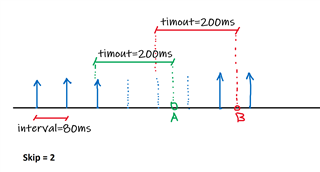Hi
I am working on an application that uses extended periodic advertising feature of BLE 5. In this sample (periodic sync):
https://github.com/nrfconnect/sdk-zephyr/blob/main/samples/bluetooth/periodic_sync/src/main.c
There are two parameters, "skip" and "timeout" which are set before making the sync at receiver side.
sync_create_param.skip = 0; sync_create_param.timeout = 0xa; err = bt_le_per_adv_sync_create(&sync_create_param, &sync);
How these two parameters affect on making/termination of the sync? And what is the difference between these two?
As I can find in the documentation (of Zephyr), it describes these parameters as follow:
skip: Maximum number of periodic advertising events that can be skipped after a successful receive.
timeout: Synchronization timeout for the periodic advertising sync.
It is not clear how the sync termination is determined, after "skipping maximum events (skip parameter)" or after "not receiving data for a while (timeout parameter)". How is it determined?

